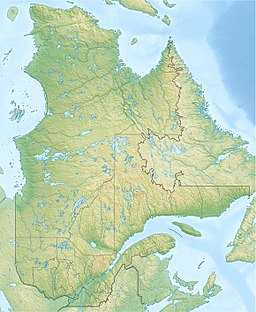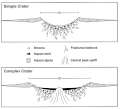geo.wikisort.org - Reservoir
The Lac Wiyâshâkimî (the official name, in French, formerly Lac à l'Eau Claire), also called the Clearwater Lakes in English, is a calque of Wiyâšâkamî in Northern East Cree (changed form of wâšâkamî or wâšekamî in more southerly Cree dialects) and Allait Qasigialingat by the Inuit,[3] are a pair of annular lakes on the Canadian Shield in Quebec, Canada, near Hudson Bay.
| Clearwater Lakes Lac à l'Eau Claire | |
|---|---|
 Clearwater Lakes as seen from a Space Shuttle (North is top right) | |
| Location | Baie-d'Hudson, Kativik, Quebec |
| Coordinates | 56°08′N 74°18′W |
| Type | Impact crater lake |
| Primary outflows | Clearwater River |
| Basin countries | Canada |
| Surface area | 1,383 km2 (534 sq mi) [1] |
| Max. depth | 178 m (584 ft) [2] |
| Surface elevation | 241 m (791 ft) [1] |

The lakes are actually a single body of water with a sprinkling of islands forming a "dotted line" between the eastern and western parts. The name is due to the clear water it holds. There are actually 25 lakes with that name in the province (26 if the Petit lac à l'Eau Claire — the Small Clearwater Lake — is included). These are the largest and northernmost, and the second largest natural lake in Quebec after Lake Mistassini.[2]
In 1896, the explorer and geologist Albert Peter Low, a member of the Geological Survey of Canada, provided a probable explanation for the lakes' descriptive Cree name by highlighting the extraordinary clarity and depth of their icy waters.[3]
Impact craters
The Clearwater Lakes occupy the near-circular depressions of two eroded impact craters (astroblemes).[4] The eastern and western craters are 26 km (16 mi) and 36 km (22 mi) in diameter, respectively.[5][6] Both craters were previously believed to have the same age, 290 ± 20 million years (Permian period),[7] promoting the long-held idea that they formed simultaneously. According to this doublet impact crater theory initially proposed by Michael R. Dence and colleagues in 1965,[8] the impactors may have been gravitationally bound as a binary asteroid, a suggestion also made by Thomas Wm. Hamilton in a 1978 letter to Sky & Telescope magazine in support of the then-controversial theory that asteroids may possess moons[9] (such as, for example, asteroid 243 Ida with its satellite Dactyl[10]).
Clearwater East and Clearwater West are both complex craters with distinct central peaks. These peaks are caused by the gravitational collapse of crater walls and subsequent rebound of the compressed crater floor. Lake water and sediments cover the central peak of Clearwater East, but bathymetric surveys of the lake floor and core drilling confirm the presence of a peak in its center.[11]
Ordovician
However, repeated 40Ar/39Ar dating of impact melt rocks from both impact craters suggests that Clearwater East has an age of approximately 460–470 million years, corresponding to the Middle Ordovician time period.[12][13]
Permian
Clearwater West was formed 286.2 ± 2.6 million years ago, in the Early Permian.[12][13] Both Clearwater impact structures also carry different geophysical (natural remanent magnetization) signatures[14] and different geochemical fingerprints of the impacting meteorite in the impact melt of each crater.[15]
Micro climate
Because of its size, Lac à l'Eau Claire can affect the local climate, as attested to by the distribution of plant species. Although the lake's shorelines are populated mainly by boreal species, the flora of the central islands in the western basin of the lake is characteristically arctic, making the islands an arctic enclave.[2]
National park
A vast area surrounding the lakes, Richmond Gulf (Lac Guillaume-Delisle), and Iberville Lake (Lac D'Iberville) are part of the 15,549 km2 (6,004 sq mi) Tursujuq National Park, Quebec's largest national park, opened in 2012.[2]
See also
- Nastapoka arc, an embayment of Hudson Bay 140 km to the west, discredited as an impact crater
References
- Statistics Canada > summary tables > Principal lakes, elevation and area, by provinces and territories Archived 2011-07-06 at the Wayback Machine
- Ministère du Développement durable, de l'Environnement et des Parcs, Provisional Master Plan Parc national des Lacs-Guillaume-Delisle-et-à-l'Eau-Claire, Quebec, 2008, ISBN 978-2-550-52710-7 (Online version Archived November 10, 2013, at the Wayback Machine)
- "Lac à l'Eau Claire" (in French). Commission de Toponymie Québec. Archived from the original on 2014-10-17. Retrieved 2009-01-30.
- Robertson, P.B. & Grieve, R.A.F. 1975 Impact structures in Canada: Their recognition and characteristics. Journal of the Royal Astronomical Society of Canada, v. 69, pp. 1-21.
- "Clearwater West". Earth Impact Database. Planetary and Space Science Centre University of New Brunswick Fredericton. Retrieved 15 September 2019.
- "Clearwater East". Earth Impact Database. Planetary and Space Science Centre University of New Brunswick Fredericton. Retrieved 15 September 2019.
- Reimold, W.U., Grieve, R.A.F. and Palme, H. 1981. Rb-Sr dating of the impact melt from East Clearwater, Quebec. Contrib. Mineral. Petrol. 76, 73–76.
- Dence, M. R., Innes, M. J. S. and Beals, C. S., 1965. On the probable meteorite origin of the Clearwater Lakes, Quebec. Royal Astronom. Soc. Canada J. 59, 13–22.
- Hamilton, Thomas Wm. Impact Craters of Earth: with Selected Craters Elsewhere. Strategic Book Publishing & Rights Agency. p. 24. ISBN 9781631353536. Retrieved 28 February 2021.
- Chapman, C.R., Veverka, J., Thomas, P.C., Klaasen, K., Belton, M.J.S., Harch, A., McEwen, A., Johnson, T.V., Helfenstein, P., Davies, M.E., Merline, W.J., Denk, T., 1995. Discovery and physical properties of Dactyl, a satellite of asteroid 243 Ida. Nature, 374, 783–784.
- A One-Two Punch by NASA Earth Observatory
- Bottomley, R.J., York, D., and Grieve, R.A.F. 1990. 40Argon-39Argon dating of impact craters. Proc. 20th Lunar Planet. Sci. Conf., LPI, Houston, pp. 421–431.
- Schmieder, M., Schwarz, W. H., Trieloff, M., Tohver, E., Buchner, E., Hopp, J. & Osinski, G. R. 2014. New 40Ar/39Ar dating of the Clearwater Lake impact structures (Québec, Canada) – Not the binary asteroid impact it seems? Geochim. Cosmochim. Acta (in press).
- Scott, R. G., Pilkington, M. and Tanczyk, E. I. 1997. Magnetic investigations of the West Hawk, Deep Bay, and Clearwater impact structures, Canada. Meteoritics Planet. Sci. 32, 293–308.
- Palme, H., Janssens, M.-J., Takahashi, H., Anders, E. and Hertogen, J. 1978. Meteoritic material at five large impact craters. Geochim. Cosmochim. Acta 42, 313–323.
External links
- Aerial Exploration of the Clearwater West Structure
- Aerial Exploration of the Clearwater East Structure
На других языках
[de] Lac à l’Eau Claire
Der Lac à l’Eau Claire (englisch Clearwater Lakes, Cree-Sprache: Wiyasakami, Innu-Sprache: Allait Qasigialingat)[2] wird gebildet aus zwei miteinander verbundenen kreisförmigen Teilseen im Kanadischen Schild in der kanadischen Provinz Québec in der Nähe der Hudson Bay.- [en] Clearwater Lakes
[es] Lagos Clearwater
Los lagos Clearwater o lago del Agua Clara (en francés, Lac à l'Eau Claire, nombre oficial; en inglés, Clearwater Lakes; en idioma cree, Wiyasakami; y en idioma inuit, Allait Qasigialingat[1]), son un par de lagos circulares canadienses localizados en el Escudo Canadiense, cerca de la bahía de Hudson, en la provincia de Quebec.[fr] Lac Wiyâshâkimî
Le lac Wiyâshâkimî, anciennement nommé le lac à l'Eau Claire, est une étendue d'eau du Québec, correspondant à un lac de cratère d'impact météorique binaire, situé dans la région administrative Nord-du-Québec, au Québec, au Canada. Il doit sa forme à deux cratères d'impact séparés par un archipel d'une dizaine de kilomètres de large. Il est situé dans le parc national Tursujuq.Другой контент может иметь иную лицензию. Перед использованием материалов сайта WikiSort.org внимательно изучите правила лицензирования конкретных элементов наполнения сайта.
WikiSort.org - проект по пересортировке и дополнению контента Википедии


